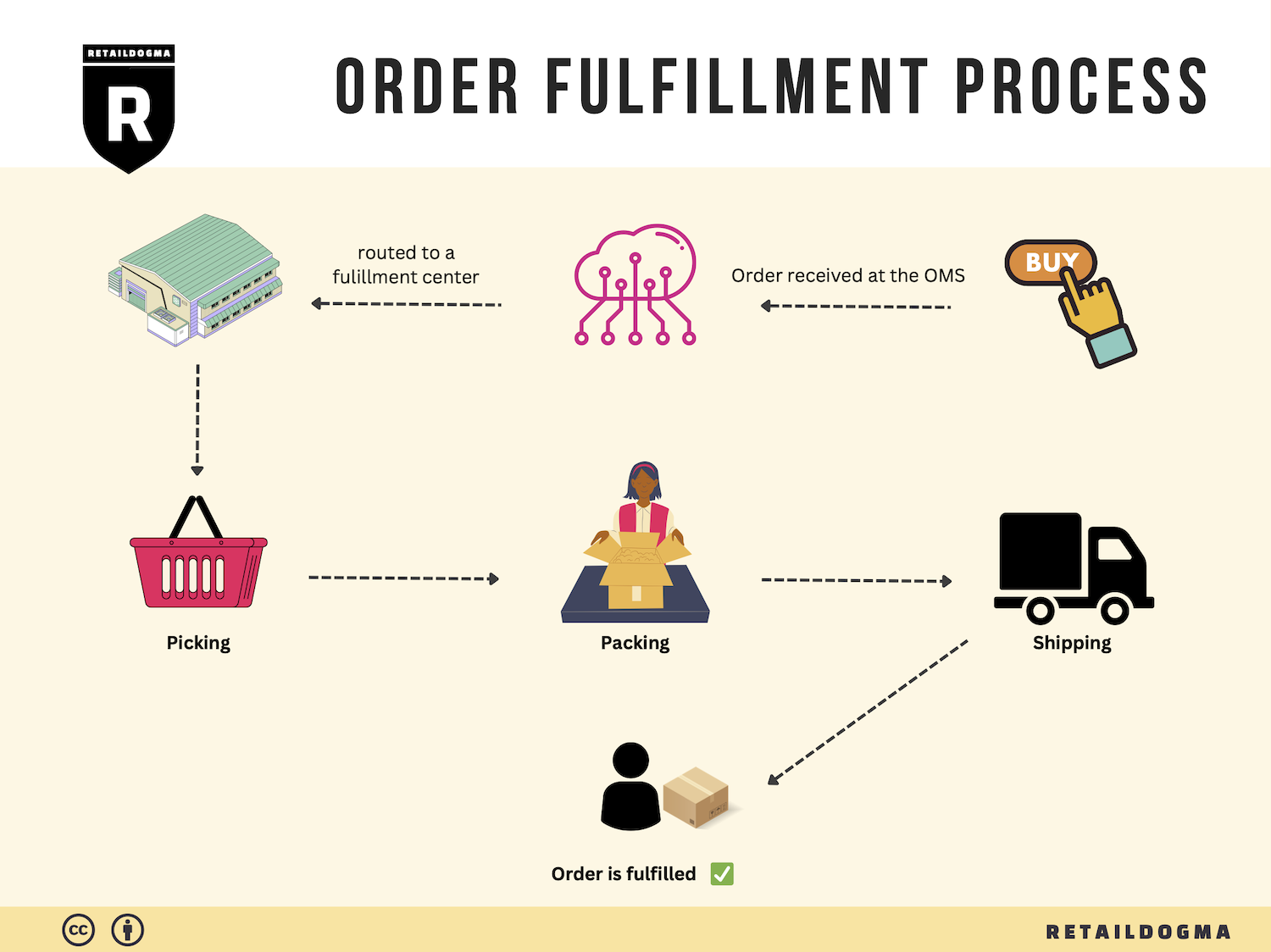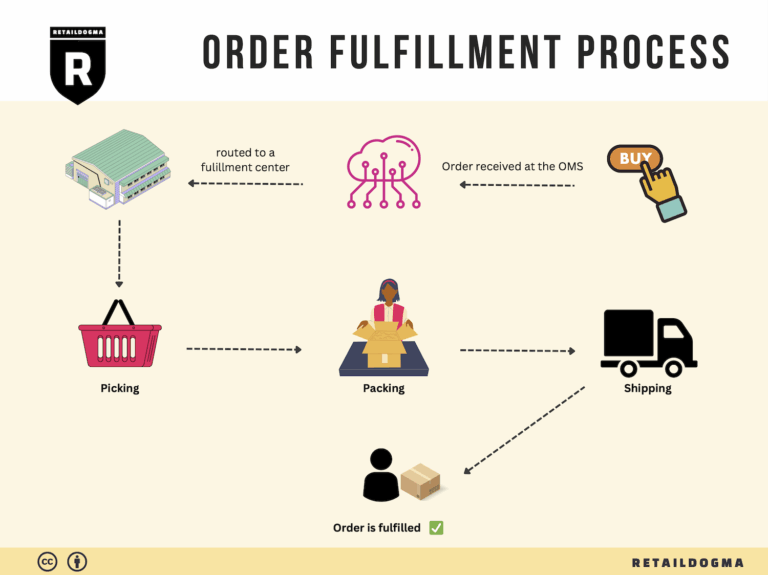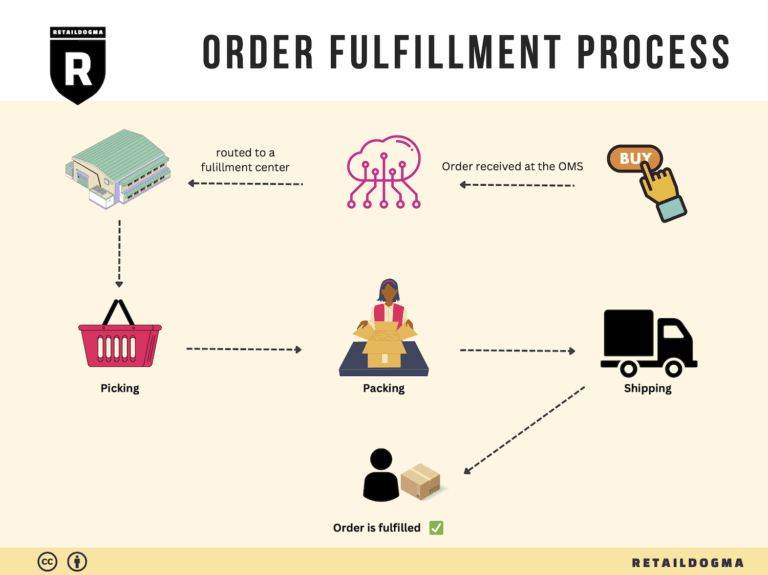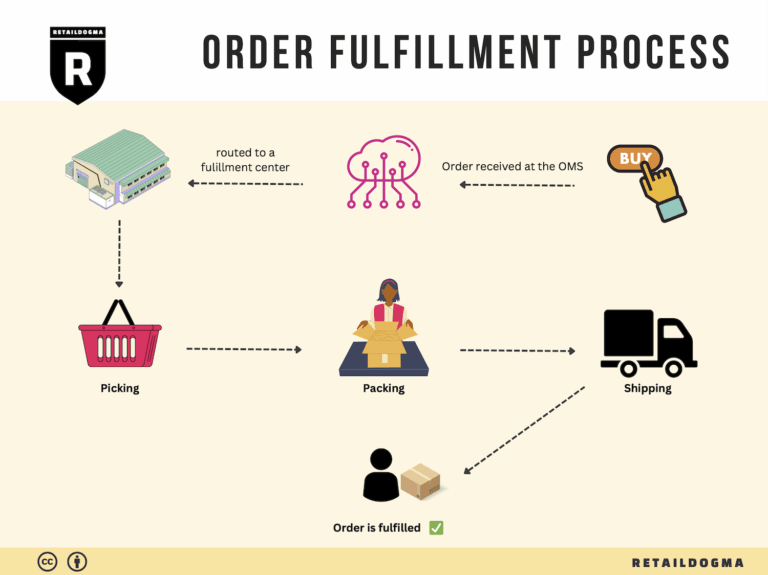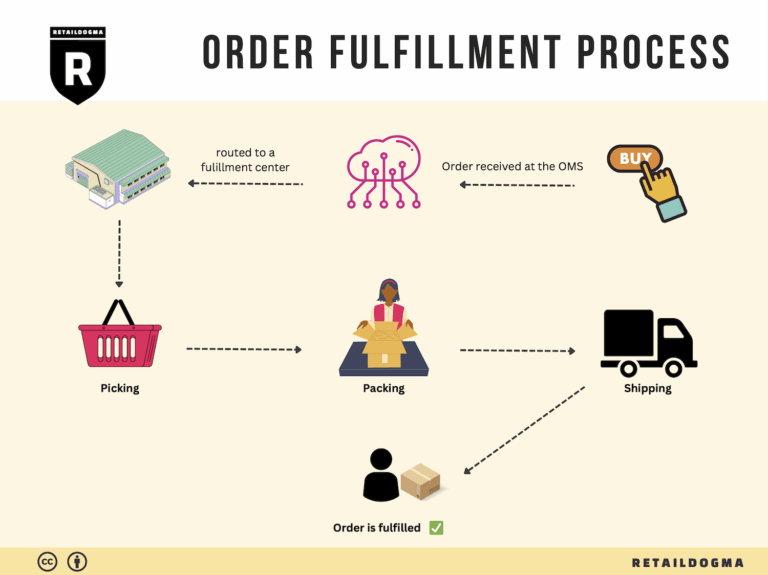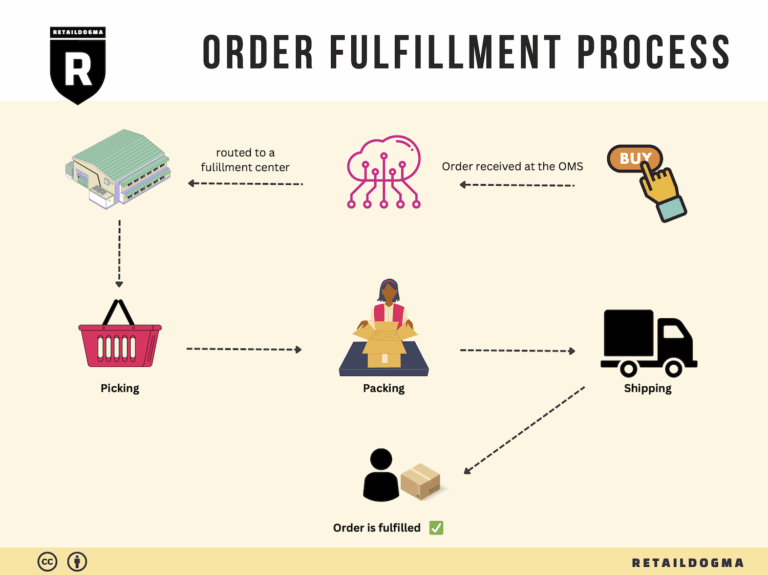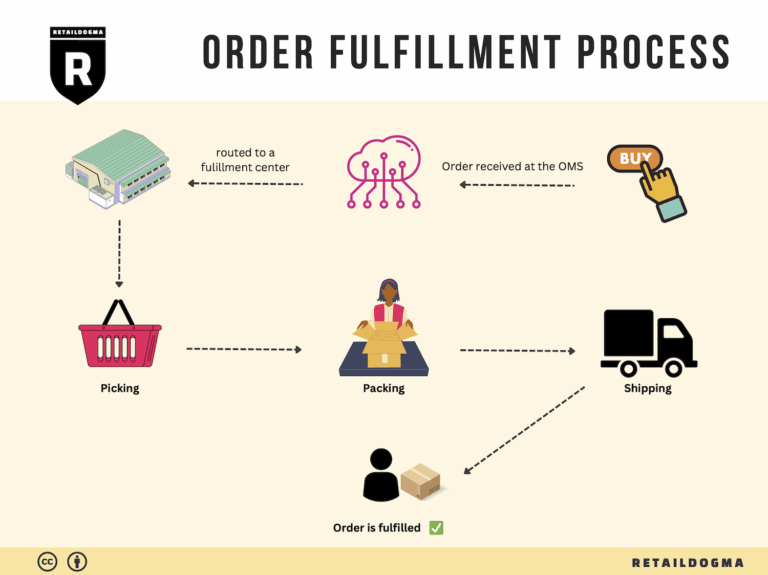Ecommerce Fulfillment Services: The Ultimate Guide (2025)
What is E-commerce Fulfillment? An Introduction for Growing Businesses
The Challenge of Packing and Shipping Orders
As your online business grows, so does the complexity of managing orders. Many entrepreneurs find themselves overwhelmed by the sheer volume of packing and shipping tasks, often sacrificing precious time that could be better spent on scaling their operations or enhancing their product offerings. This common pain point can lead to delays, fulfillment errors, and ultimately, dissatisfied customers.
Understanding E-commerce Fulfillment
At its core, e-commerce fulfillment is the process of getting products from your warehouse to your customers’ doorsteps. This involves several key steps: receiving inventory, storing products, picking and packing orders, and managing shipping logistics. A seamless fulfillment process is not just a backend operation; it’s a crucial factor in your business’s success, impacting customer satisfaction, loyalty, and your bottom line.
What This Guide Covers
In this comprehensive guide, we will explore various e-commerce fulfillment models, including Third-Party Logistics (3PL) and Fulfillment by Amazon (FBA). Each model offers distinct advantages and considerations, making it essential for you to understand which aligns best with your business goals.
We will delve into core fulfillment services, such as inventory management, order processing, and returns handling. Understanding these components will empower you to streamline your operations and improve customer experiences.
Choosing the right fulfillment partner is another critical aspect we will address. With numerous options available, knowing how to evaluate potential partners based on their capabilities, technology, and service levels can save you time and reduce operational headaches.
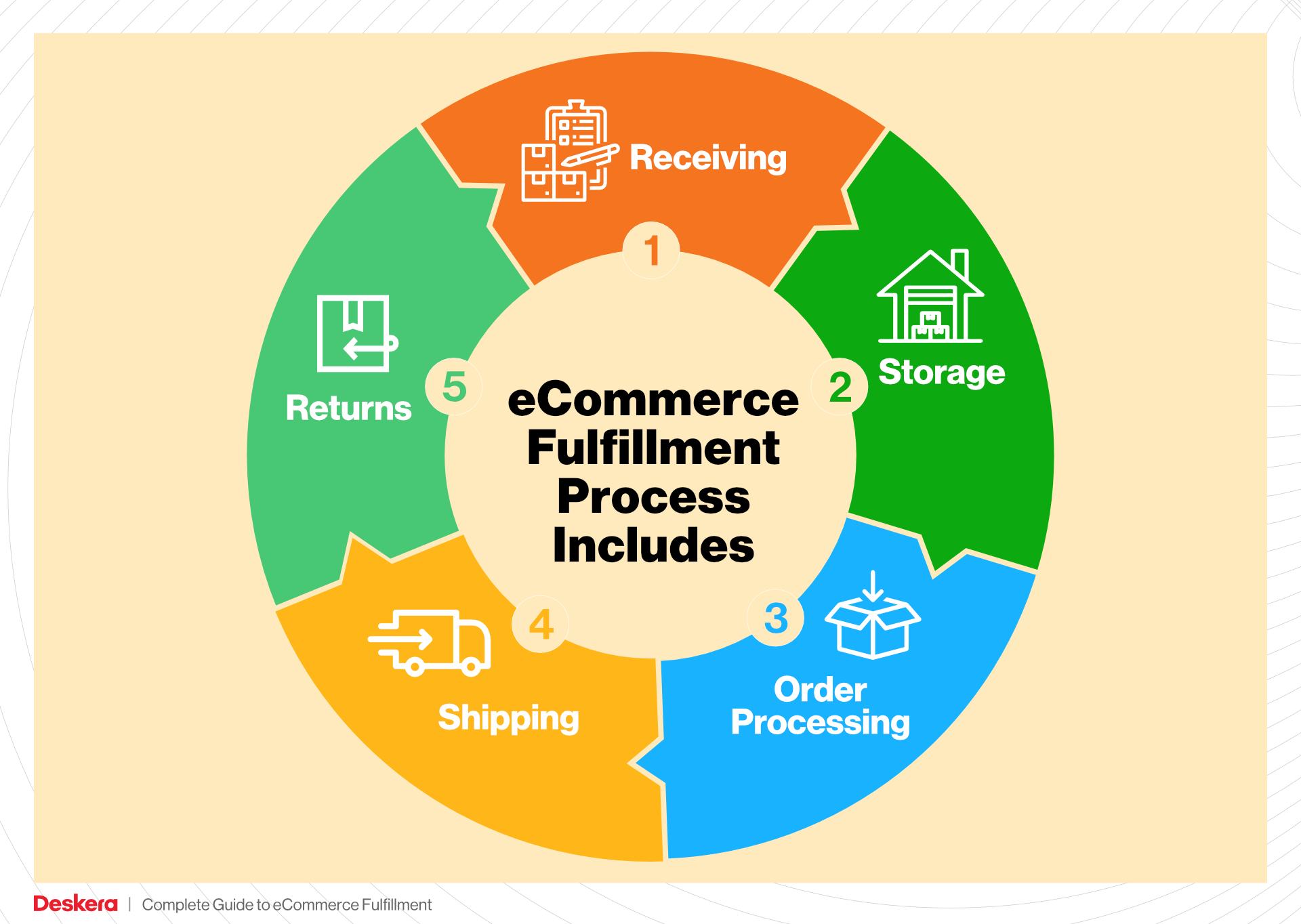
Finally, we will provide insights on pricing structures within the fulfillment landscape. Understanding the cost implications of different fulfillment strategies will help you make informed decisions that balance quality service with financial sustainability.
Empowering Your Business
The ultimate goal of this guide is to equip you with the knowledge and tools necessary to make smart, strategic decisions about your logistics operations. By understanding the intricacies of e-commerce fulfillment, you can position your business for growth and ensure that your customers receive the exceptional service they expect. Let’s dive into the world of e-commerce fulfillment and unlock the potential of your growing business.
What You’ll Learn In This Guide
- What is E-commerce Fulfillment? An Introduction for Growing Businesses
- The Order Fulfillment Process: From ‘Buy’ Button to Customer’s Door
- Comparing Fulfillment Models: In-House vs. 3PL vs. Dropshipping
- A Deep Dive into Amazon FBA: Pros, Cons, and Who It’s For
- Core Services Offered by Fulfillment Centers
- How to Choose a Fulfillment Partner: A 6-Point Checklist
- Understanding Fulfillment Pricing: A Breakdown of Common Fees
- Frequently Asked Questions (FAQs) about Fulfillment
- Conclusion: Is Outsourcing Fulfillment the Right Move for Your Business?
- Important Disclaimer
The Order Fulfillment Process: From ‘Buy’ Button to Customer’s Door
1. Receiving Inventory
The order fulfillment process begins with receiving inventory at the fulfillment center. When your products arrive, they are unloaded at designated receiving bays. It’s crucial to provide an Advance Shipping Notice (ASN) to the warehouse, detailing the shipment’s contents and expected arrival time. This allows warehouse staff to prepare for the incoming goods, ensuring a smooth unloading process.
Receiving is vital because it sets the foundation for your inventory accuracy. During this step, warehouse personnel check the shipment against the ASN to identify any discrepancies or damages. Efficient receiving minimizes the time products spend on the loading dock and accelerates the transition to inventory status. A key term here is SKU (Stock Keeping Unit), which is essential for tracking inventory accurately. Proper handling during this step prevents costly errors down the line and ensures that products are available for quick order fulfillment.
2. Warehouse Storage
Once products are received and processed, they are stored in the fulfillment center. Effective warehouse storage involves organizing inventory in a manner that facilitates efficient picking and packing. This could include labeling aisles and shelves and implementing a Warehouse Management System (WMS) that tracks the location of each SKU.
The importance of this step lies in its impact on order fulfillment speed and accuracy. A well-organized warehouse allows for faster retrieval of items, reducing the time it takes to fulfill an order. Common strategies include placing high-velocity items closer to packing stations and utilizing zone picking to streamline the picking process. Inventory management is the key term associated with this step, as it involves tracking stock levels to ensure you meet customer demand without overstocking.
3. Order Picking
When a customer places an order, the next step is order picking. The WMS generates a pick list based on the items ordered, detailing their locations within the warehouse. Pickers then use this list to retrieve the necessary SKUs from storage.
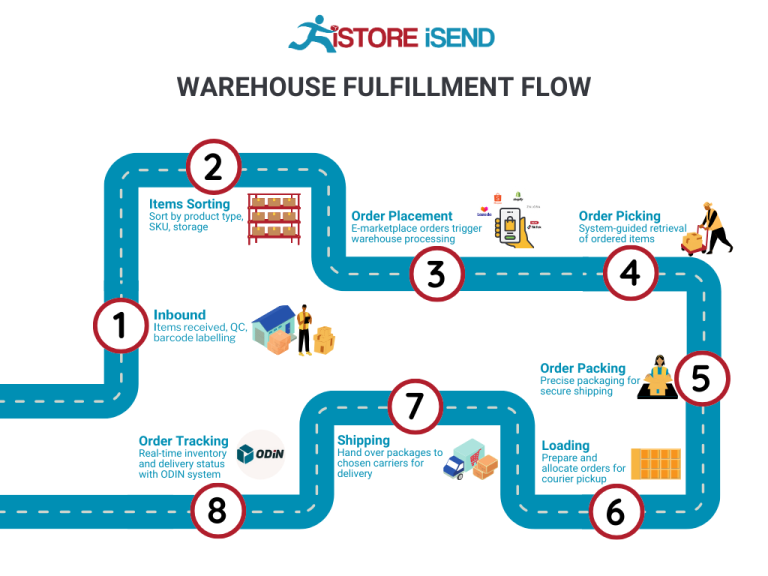
Order picking is critical for maintaining customer satisfaction, as the speed and accuracy of this process directly affect delivery times. There are various picking methods, such as single order picking for smaller operations or wave picking for larger warehouses, where multiple orders are picked simultaneously. This efficiency not only saves time but also reduces labor costs. The key term here is pick lists, which guide the pickers in collecting the correct items for each order.
4. Order Packing
After items are picked, they move to the packing station. Here, packers secure the products in appropriate-sized boxes, adding protective materials as needed to prevent damage during transit. They then seal the boxes and apply shipping labels.
Packing is a crucial step because it ensures that products arrive at their destination in pristine condition. A well-executed packing process minimizes the risk of returns due to damage, which can erode profit margins and harm customer satisfaction. It’s essential to choose the right box size and packing materials, considering the fragility of the items. The associated key term for this stage is packing slips, which accompany orders to provide customers with information about their purchase.
5. Shipping & Delivery
The final step in the order fulfillment process is shipping and delivery. Once packed, boxes are transferred to the outbound dock, where shipping staff verify labels and prepare packages for carriers like UPS, FedEx, or USPS. The choice of carrier and shipping method can significantly influence delivery speed and cost.
Effective shipping is vital for customer satisfaction and brand loyalty. Fast and reliable delivery can differentiate your e-commerce business in a crowded marketplace. Selecting a fulfillment partner with strategically located warehouses can further enhance shipping efficiency, enabling you to reach most of your customer base within two days. The key term associated with this step is last-mile delivery, which refers to the final leg of the delivery journey and is often the most crucial for customer experience.
By understanding and optimizing each of these five steps—receiving inventory, warehouse storage, order picking, order packing, and shipping & delivery—you can build a robust fulfillment process that enhances customer satisfaction and drives business growth.
Comparing Fulfillment Models: In-House vs. 3PL vs. Dropshipping
Fulfillment Model Comparison Table
| Model | Who Handles Inventory | Best For (Business Stage) | Key Advantage | Key Disadvantage |
|---|---|---|---|---|
| In-House Fulfillment | The business itself | Startups to established brands | Greater control over inventory and processes | High overhead costs and resource demands |
| Third-Party Logistics (3PL) | 3PL provider | Growing businesses scaling up | Flexibility and access to expertise | Less control over logistics operations |
| Dropshipping | Supplier/vendor | New entrepreneurs and niche markets | Low upfront investment and inventory risk | Lower profit margins and potential quality issues |
In-House Fulfillment
In-house fulfillment involves managing the entire logistics process within your own facility. This model is ideal for businesses that have the resources and scale to invest in warehousing, staffing, and technology. By handling inventory directly, companies retain full control over their operations, allowing for customized processes and immediate responsiveness to customer demands. This can be particularly beneficial for brands that require specialized handling or packaging of their products. However, maintaining an in-house operation comes with significant overhead costs, including rent, utilities, labor, and technology investments. Additionally, as order volumes grow, managing fulfillment can become increasingly complex and resource-intensive, potentially diverting focus from core business activities like marketing and product development.
Third-Party Logistics (3PL)
Third-party logistics (3PL) providers offer a comprehensive solution for businesses looking to streamline their fulfillment processes. With a 3PL, the responsibility for inventory management, warehousing, order processing, and shipping is outsourced to an external partner. This model is particularly beneficial for growing businesses that may not have the capacity or expertise to manage logistics efficiently. 3PL providers typically leverage advanced technologies, extensive shipping networks, and industry expertise, allowing businesses to scale quickly without the burden of managing logistics in-house. However, while 3PLs offer flexibility and operational efficiency, businesses may experience a loss of control over logistics processes. Relying on an external provider can lead to challenges in maintaining consistent service quality, inventory accuracy, and integration with existing systems.
Dropshipping
Dropshipping is a fulfillment model where the retailer does not hold inventory but instead relies on suppliers to ship products directly to customers. This model is particularly appealing to new entrepreneurs and those operating in niche markets, as it requires minimal upfront investment in inventory and significantly reduces financial risk. With dropshipping, businesses can offer a wide range of products without the complexities of managing stock, warehousing, or fulfillment logistics. However, the dropshipping model often comes with lower profit margins due to reliance on suppliers for pricing and fulfillment. Additionally, businesses may face challenges related to quality control, as they have limited oversight over the products being shipped. Shipping times can also be longer, leading to potential customer dissatisfaction if suppliers do not meet delivery expectations. As a result, businesses must carefully select their suppliers and maintain clear communication to ensure a positive customer experience.
In conclusion, each fulfillment model presents unique advantages and challenges, making the choice dependent on specific business needs, growth stage, and operational capabilities. Understanding these differences will help e-commerce business owners make informed decisions that align with their strategic objectives.
A Deep Dive into Amazon FBA: Pros, Cons, and Who It’s For
Understanding Fulfillment by Amazon (FBA)
Fulfillment by Amazon (FBA) is a service offered by Amazon that allows e-commerce sellers to leverage Amazon’s vast logistics network to store, pack, and ship their products. By utilizing FBA, sellers send their inventory to Amazon’s fulfillment centers, where Amazon takes care of the entire order fulfillment process. This includes storing the products, picking and packing orders, shipping them to customers, and even handling customer service inquiries and returns.
When a customer places an order for a product listed as FBA, Amazon handles all aspects of the transaction. The seller’s products become eligible for Amazon Prime, providing customers with benefits such as fast, free shipping, which can significantly increase sales potential. The process is designed to simplify logistics for sellers, allowing them to focus more on product development and marketing rather than the complexities of order fulfillment.
How FBA Works
-
Inventory Preparation: Sellers prepare their products according to Amazon’s guidelines, which include packaging and labeling requirements. This ensures that items are ready for efficient handling upon arrival at the fulfillment center.
-
Shipping to Amazon: Sellers ship their inventory to Amazon’s fulfillment centers. Amazon provides specific addresses and guidelines for shipping, which can include sending products to multiple locations based on demand forecasts.
-
Storage: Once received, products are stored in Amazon’s warehouses. Amazon uses advanced inventory management systems to track stock levels and optimize storage.
-
Order Processing: When a customer places an order, Amazon’s system automatically picks, packs, and ships the product on behalf of the seller. This process is often completed within hours.
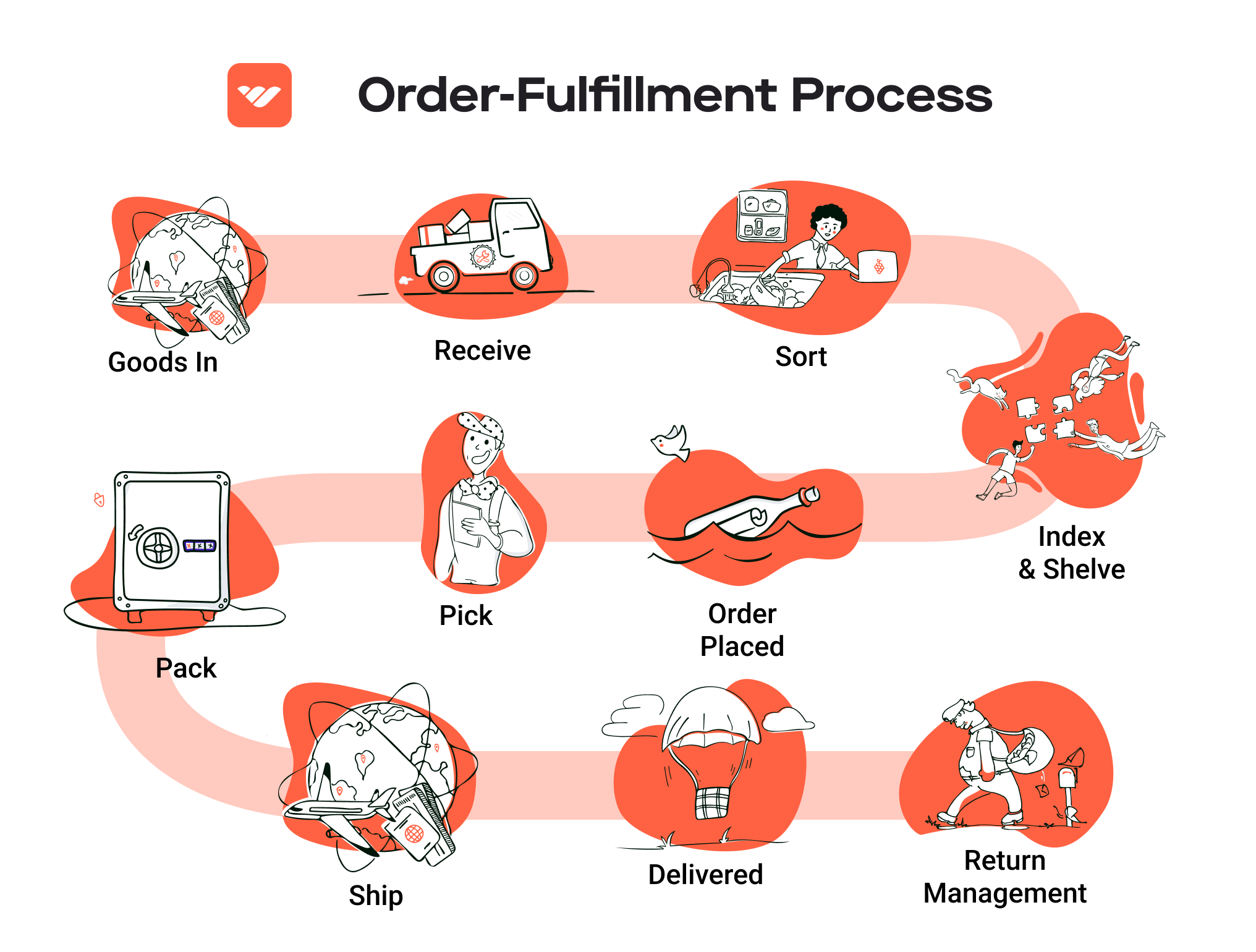
-
Customer Service and Returns: Amazon also manages customer service for FBA orders, handling inquiries and processing returns. This reduces the workload for sellers and enhances the customer experience.
Pros of Using FBA
-
Prime Eligibility: One of the most significant advantages of FBA is that products become eligible for Amazon Prime. This can lead to increased visibility and sales, as Prime members are more likely to purchase items with fast shipping options.
-
Customer Trust: Amazon is a trusted name in e-commerce. By using FBA, sellers can leverage Amazon’s brand reputation, which can enhance customer confidence in purchasing from their listings.
-
Multi-Channel Fulfillment: FBA isn’t limited to sales on Amazon. Sellers can use FBA to fulfill orders from their own websites or other marketplaces, streamlining their logistics across different sales channels.
-
Scalability: FBA allows sellers to scale their operations without the need for significant investment in warehousing and logistics infrastructure. This is especially beneficial for small to medium-sized businesses looking to grow.
-
Simplified Logistics: With Amazon handling storage, packing, and shipping, sellers can focus on other aspects of their business, such as marketing and product development.
Cons of Using FBA
-
High Fees: While FBA offers many benefits, it also comes with costs. Sellers must pay storage fees for inventory held in Amazon’s warehouses, as well as fulfillment fees for each order processed. These fees can eat into profit margins, particularly for low-cost items.
-
Strict Inventory Rules: Amazon has stringent inventory management policies, including guidelines on how to prepare and package products. Sellers must adhere to these rules strictly to avoid penalties or the removal of their listings.
-
Commingling Risks: FBA operates on a commingling model, meaning that inventory from different sellers can be stored together. While this can simplify logistics, it also poses risks. If a customer receives a defective item, it may be difficult for the seller to determine whether the product originated from their stock or another seller’s.
-
Limited Control Over Shipping: Sellers have limited control over shipping methods and times once their products are in Amazon’s hands. This can be a disadvantage if a seller wants to provide a unique shipping experience or faster delivery options.
-
Inventory Management Challenges: Maintaining optimal inventory levels can be tricky with FBA, as sellers need to predict demand accurately. Overestimating can lead to high storage fees, while underestimating can result in stockouts and lost sales.
Who is FBA Best For?
Fulfillment by Amazon is best suited for sellers who:
-
Have a High Sales Volume: Businesses that sell a large number of products can benefit from FBA due to economies of scale in shipping and storage.
-
Sell Consumer Products: FBA is particularly advantageous for sellers in consumer goods categories that are frequently purchased, as these items can benefit from the Prime membership and increased visibility.
-
Are Looking to Scale: Sellers aiming to grow their business without investing heavily in logistics infrastructure will find FBA a practical solution.
-
Desire Simplified Logistics: Entrepreneurs who prefer to focus on marketing and product development rather than the complexities of fulfillment will appreciate the convenience that FBA offers.
-
Can Manage the Costs: Businesses that can effectively manage the fees associated with FBA and maintain healthy profit margins will find the service beneficial.
In conclusion, while FBA provides numerous advantages, it is essential for sellers to carefully evaluate their business model and product offerings before deciding to adopt this fulfillment strategy. Understanding both the pros and cons will enable e-commerce businesses to make informed decisions that align with their growth objectives.
Core Services Offered by Fulfillment Centers
Inventory Management & Warehousing
Inventory management and warehousing are foundational services provided by fulfillment centers that directly impact an e-commerce business’s operational efficiency and profitability. This service involves receiving bulk goods, storing them securely, and maintaining an organized inventory system that ensures products are readily available for order fulfillment.
What It Is:
Fulfillment centers manage the entire lifecycle of inventory, starting from the receipt of goods to their storage in a warehouse. This process includes logging items into a Warehouse Management System (WMS), categorizing them for easy access, and implementing security measures to prevent loss. Warehouses utilize various inventory management strategies, such as Just-In-Time (JIT) inventory or Economic Order Quantity (EOQ), to optimize stock levels based on demand forecasts.
Benefits:
1. Reduced Overhead Costs: By outsourcing inventory management, e-commerce businesses can minimize costs associated with maintaining a physical storefront or managing large in-house warehouse operations.
2. Improved Accuracy: Advanced inventory management systems enhance tracking and reduce errors, ensuring that businesses have the right products available when customers place orders.
3. Scalability: As your business grows, fulfillment centers can easily adjust inventory levels and storage space, allowing for smooth scaling without the need for significant capital investment in infrastructure.
Pick and Pack Services
Pick and pack services are critical components of the fulfillment process, enabling efficient order processing and shipping. This service involves selecting the right items from inventory based on customer orders, packing them securely, and preparing them for shipment.
What It Is:
When an order is placed, the fulfillment center’s WMS generates a pick list that indicates which items need to be collected. Workers then ‘pick’ these items from their designated storage locations and ‘pack’ them into boxes or envelopes, applying appropriate shipping labels before dispatching them to the customer.
Benefits:
1. Faster Order Fulfillment: Efficient pick and pack processes can significantly reduce the time between order placement and shipment, enhancing customer satisfaction and loyalty.
2. Accuracy in Orders: Utilizing technology such as barcode scanning ensures that the correct items are picked, which minimizes returns and increases customer trust.
3. Flexibility in Order Sizes: Fulfillment centers can handle varying order sizes, from single-item purchases to bulk orders, providing businesses with the flexibility to accommodate different customer needs.
Kitting and Assembly
Kitting and assembly services allow e-commerce businesses to offer customized products or bundled items efficiently. This service involves grouping multiple products together into a single kit or assembling components into a final product before shipping.
What It Is:
Kitting entails assembling individual items into a package or set, such as creating gift baskets or product bundles. Assembly may involve more complex tasks, like putting together a multi-part product that requires specific instructions or tools.
Benefits:
1. Enhanced Product Offerings: Kitting enables businesses to create unique product offerings that can attract new customers and increase average order value.
2. Streamlined Operations: By outsourcing kitting and assembly to fulfillment centers, e-commerce businesses can focus on core activities like marketing and customer service while ensuring that product preparation is handled efficiently.
3. Reduced Handling Costs: Centralizing the kitting process in a fulfillment center can lower costs associated with labor and materials, as fulfillment centers are equipped to handle these tasks at scale.
Returns Management (Reverse Logistics)
Returns management, often referred to as reverse logistics, is an essential service for any e-commerce operation. This service encompasses the processes involved in handling returned merchandise and ensuring that items are reintegrated into inventory or disposed of properly.
What It Is:
Fulfillment centers manage the entire returns process, from receiving returned products to evaluating their condition and determining the best course of action—whether restocking, refurbishing, or recycling them. This process often includes updating inventory levels in real-time to maintain accurate stock counts.
Benefits:
1. Customer Satisfaction: A streamlined returns process enhances the customer experience by making it easy for shoppers to return unwanted items, which can increase brand loyalty and repeat purchases.
2. Cost Savings: Efficient returns management can reduce the costs associated with handling returns and minimize losses by ensuring that sellable items are quickly returned to inventory.
3. Data Insights: Analyzing return data can provide valuable insights into customer behavior and product quality, helping businesses make informed decisions about inventory and product development.
By leveraging these core services offered by fulfillment centers, e-commerce businesses can optimize their operations, reduce costs, and enhance the overall customer experience, allowing them to focus on growth and scalability in a competitive market.
How to Choose a Fulfillment Partner: A 6-Point Checklist
Location & Warehouse Network
Importance: The geographical location of your fulfillment partner’s warehouses significantly impacts shipping times and costs. A strategically placed warehouse can reduce transit times to your customer base, enhancing customer satisfaction and retention.
Questions to Ask:
– Where are your warehouses located?
– How many warehouses do you operate, and how are they distributed across key markets?
– Can you provide shipping time estimates to my primary customer regions?
– What are your shipping partnerships, and do you have multiple carrier options to ensure flexibility and cost-effectiveness?
Technology & Integrations
Importance: The technology used by your fulfillment partner is crucial for seamless operations. Effective Warehouse Management Systems (WMS) and integration capabilities with your e-commerce platform can streamline order processing, inventory management, and data analytics.
Questions to Ask:
– What technology platforms do you use for order processing and inventory management?
– How does your WMS integrate with major e-commerce platforms (e.g., Shopify, WooCommerce, Magento)?
– Do you provide real-time inventory tracking and reporting?
– How do you handle order updates and customer notifications?
Specializations (e.g., Cold Storage, Oversized Items)
Importance: Different e-commerce businesses have unique fulfillment needs. If your products require specific handling—such as temperature control for perishables or special storage for oversized items—it’s essential to partner with a 3PL that has the necessary capabilities.
Questions to Ask:
– Do you specialize in any particular type of fulfillment, such as cold storage or handling oversized items?
– What measures do you take to ensure product integrity during storage and shipping?
– Can you manage specialized packaging or labeling requirements?
– Have you worked with businesses in my industry before, and can you provide case studies or references?
Scalability & Capacity
Importance: As your business grows, your fulfillment needs will evolve. Choosing a partner that can scale with your operations ensures that you can meet increasing demand without disruption.
Questions to Ask:
– What is your current capacity, and how do you manage peak seasons or unexpected spikes in order volume?
– Can you accommodate seasonal fluctuations in inventory and order volume?
– How quickly can you scale operations to meet my business growth?
– What contingency plans do you have in place for operational disruptions or capacity limitations?
Pricing and Contracts
Importance: Understanding the pricing structure and contract terms is vital for budgeting and financial forecasting. A transparent pricing model helps you avoid unexpected costs that can erode profit margins.
Questions to Ask:
– What pricing model do you use (e.g., per order, storage fees, pick-and-pack fees)?
– Are there any additional fees that I should be aware of, such as for returns or inventory management?
– What are the contract terms, and is there flexibility for renegotiation as my business grows?
– Can you provide a detailed breakdown of estimated costs based on my projected order volume?
Customer Support & Reviews
Importance: Reliable customer support can be a game-changer when issues arise. Additionally, checking reviews and testimonials from other clients provides insight into the partner’s reliability and service quality.
Questions to Ask:
– What level of customer support do you provide (e.g., dedicated account manager, 24/7 support)?
– How do you handle issues or disputes, and what is your typical response time?
– Can you provide references from current or past clients?
– What has been the feedback from your clients regarding your services, and how do you address any negative reviews?
Conclusion
Choosing the right fulfillment partner is a crucial decision for e-commerce businesses aiming to scale. By focusing on these six key areas—location, technology, specialization, scalability, pricing, and customer support—you can make a well-informed choice that aligns with your operational needs and long-term growth objectives. Prioritize these factors in your discussions with potential partners to ensure that your fulfillment logistics are a robust foundation for your business success.
Understanding Fulfillment Pricing: A Breakdown of Common Fees
Initial Setup Fees
Initial setup fees are one-time charges incurred when you first engage a fulfillment service. These fees cover the costs associated with onboarding your products into the fulfillment center’s system. Typically, they encompass the following:
- Account Setup: This involves creating your account in the fulfillment center’s warehouse management system (WMS) and integrating it with your e-commerce platform.
- Inventory Setup: This includes entering your product details, assigning SKU numbers, and inputting inventory levels.
- Warehouse Configuration: If your products require special handling or storage solutions, additional costs may be included to configure the warehouse accordingly.
The calculation of initial setup fees can vary widely between providers, often ranging from a few hundred to several thousand dollars, depending on the complexity and volume of your inventory. It’s essential to clarify what these fees entail and whether they are negotiable based on your anticipated order volume.
Receiving Fees
Receiving fees are charged when your products arrive at the fulfillment center. This fee covers the labor and resources needed to unload, inspect, and catalog your inventory. Key aspects include:
- Unloading Products: Workers will unload your shipment and check it against the advance shipping notice (ASN).
- Inventory Logging: Each product must be entered into the WMS, ensuring accurate inventory levels.
- Quality Control: This may involve inspecting items for damages or discrepancies.
Receiving fees are generally calculated on a per-pallet or per-unit basis, with costs typically ranging from $20 to $50 per pallet and $0.50 to $2 per individual item, depending on the volume and the specific provider’s practices. It’s crucial to understand how these fees apply to your shipments, as they can significantly impact your overall fulfillment costs.
Storage Fees (per pallet/bin)
Storage fees are recurring charges for keeping your products in the fulfillment center’s warehouse. This fee can be structured in different ways, commonly based on the following:
- Pallet Storage: Fees calculated per pallet stored, which typically ranges from $15 to $30 per pallet per month.
- Bin Storage: For smaller items stored in bins, fees may be calculated on a per-bin basis, often around $5 to $15 per bin per month.
Storage fees can be influenced by various factors, including the location of the warehouse (urban areas may charge more) and the type of products being stored (hazardous materials may incur additional fees). To manage these costs effectively, regularly monitor your inventory levels and optimize stock to avoid overages.
Pick & Pack Fees (per item/order)
Pick and pack fees are charged for the labor involved in retrieving items from storage and preparing them for shipment. These fees can be structured in several ways:
- Per Item: A fee charged for each item picked, usually ranging from $0.20 to $2 per item.
- Per Order: A flat fee for each order processed, which can range from $1 to $5, depending on the complexity of the order.
These fees can add up quickly, especially for businesses with a high volume of orders. To minimize costs, consider optimizing your product offerings and order sizes to ensure efficiency in the picking process. Additionally, inquire about tiered pricing, where the per-item fee decreases with higher volumes.
Shipping Fees
Shipping fees are the costs associated with delivering your products to customers. These fees can vary widely based on several factors:
- Carrier Selection: Different carriers (UPS, FedEx, USPS) have varying rates based on service levels (ground, express, etc.).
- Destination: Shipping costs can escalate based on the distance from the warehouse to the customer, with international shipping being significantly more expensive.
- Package Dimensions and Weight: Heavier and larger packages typically incur higher shipping fees.
Shipping fees are usually calculated based on weight, dimensions, and destination, with costs ranging from a few dollars for small, local shipments to $100 or more for larger items or expedited services. Partnering with a fulfillment center that has negotiated shipping rates can help reduce these costs significantly.
Tips for Getting an Accurate Quote
- Provide Detailed Product Information: Offer comprehensive details about your products, including size, weight, and any special handling requirements.
- Estimate Order Volumes: Share your anticipated order volumes, as many fulfillment centers offer discounts for higher volumes.
- Ask About Additional Fees: Inquire about any potential hidden fees, such as returns processing or long-term storage fees.
- Request Multiple Quotes: Don’t settle for the first quote; gather multiple proposals to compare services and pricing.
- Evaluate Service Levels: Understand what each provider includes in their pricing, such as customer service, inventory management software, and returns handling.
By taking these steps, you can ensure a more accurate and comprehensive understanding of your fulfillment costs, allowing you to make informed decisions that align with your business growth objectives.
Frequently Asked Questions (FAQs) about Fulfillment
1. What is e-commerce fulfillment?
E-commerce fulfillment refers to the entire process of receiving, storing, picking, packing, and shipping products to customers who place orders online. It encompasses managing inventory, processing orders efficiently, and handling returns, all aimed at ensuring timely and accurate delivery to enhance customer satisfaction.
2. What’s the difference between a warehouse and a fulfillment center?
A warehouse is primarily a storage facility where goods are kept until needed. In contrast, a fulfillment center is a specialized type of warehouse designed to handle the entire order fulfillment process, including picking, packing, shipping, and managing returns. Fulfillment centers focus on fast processing and delivery of e-commerce orders.
3. What is a 3PL (Third-Party Logistics)?
A 3PL is a service provider that manages logistics operations for businesses, including warehousing, inventory management, order fulfillment, and shipping. By outsourcing these functions to a 3PL, e-commerce businesses can focus on core activities like marketing and product development while benefiting from the expertise and resources of logistics specialists.
4. How much do fulfillment services cost?
The cost of fulfillment services varies based on factors such as order volume, storage space, picking and packing requirements, and shipping methods. Typically, fulfillment centers charge fees for storage (per cubic foot), order processing (per order or per item), and shipping (based on weight and destination). It’s essential to request quotes from multiple providers to find the best fit for your budget and needs.
5. How does the order fulfillment process work?
The order fulfillment process generally follows these steps:
1. Receiving: Products are delivered to the fulfillment center and logged into the inventory system.
2. Storage: Items are organized in the warehouse for easy access.
3. Picking: When an order is placed, the system generates a pick list, and staff retrieve the items.
4. Packing: Picked items are securely packed for shipping.
5. Shipping: The package is handed off to a carrier for delivery to the customer.
6. Returns: If needed, returned items are processed and handled according to the store’s return policy.
6. What are the benefits of using a fulfillment service?
Using a fulfillment service can provide several advantages, including:
– Scalability: Easily manage increased order volumes without the need for significant investment in infrastructure.
– Expertise: Leverage the knowledge of logistics professionals to improve efficiency and reduce errors.
– Cost-Effectiveness: Potentially lower shipping rates and reduced operational costs through economies of scale.
– Focus on Core Business: Free up time and resources to concentrate on marketing, sales, and customer service.
7. What factors should I consider when choosing a fulfillment partner?
When selecting a fulfillment partner, consider the following factors:
– Location: Choose a provider with warehouses strategically located to minimize shipping times and costs to your customer base.
– Technology: Look for integration capabilities with your e-commerce platform and inventory management systems.
– Experience: Assess the provider’s experience in your industry and their track record with similar businesses.
– Scalability: Ensure they can accommodate your growth and changing order volumes.
– Customer Service: Evaluate their responsiveness and support capabilities.
8. How do I manage inventory effectively in a fulfillment center?
Effective inventory management in a fulfillment center involves:
– Regular Audits: Conduct frequent inventory counts to ensure accuracy.
– Utilizing Technology: Implement inventory management software to track stock levels and movements.
– Forecasting Demand: Analyze sales data to anticipate inventory needs and avoid stockouts or overstocking.
– Strategic Storage: Organize inventory based on sales volume and product categories to streamline picking processes.
9. What is the role of returns processing in fulfillment logistics?
Returns processing is a critical aspect of fulfillment logistics, as it directly impacts customer satisfaction and inventory management. A well-defined returns process allows customers to return products easily, and efficient handling of returns helps recover value from returned items, whether by restocking, refurbishing, or liquidating. This process should be integrated with the overall fulfillment strategy to minimize disruptions.
10. How can I improve the speed of my order fulfillment?
To enhance the speed of your order fulfillment, consider the following strategies:
– Optimize Warehouse Layout: Arrange products to reduce travel time for pickers.
– Implement Automated Systems: Use warehouse management systems (WMS) to streamline picking and packing processes.
– Train Staff: Ensure your team is well-trained in efficient picking and packing methods.
– Offer Multiple Shipping Options: Provide customers with various shipping choices to cater to their needs while maintaining efficient processing.
– Monitor Performance Metrics: Regularly review fulfillment metrics to identify bottlenecks and areas for improvement.
Conclusion: Is Outsourcing Fulfillment the Right Move for Your Business?
Evaluating the Benefits of Outsourcing Fulfillment
Outsourcing fulfillment can be a transformative decision for e-commerce businesses looking to scale effectively. By leveraging a third-party logistics (3PL) provider, you can save valuable time that would otherwise be spent on inventory management, order processing, and shipping logistics. This allows you to focus on what truly matters: growing your brand, enhancing customer engagement, and improving product offerings.
Moreover, scalability is one of the standout advantages of utilizing fulfillment services. As your sales volume fluctuates—whether due to seasonal trends or marketing campaigns—an adept fulfillment partner can easily adjust operations to meet your demands without the overhead of managing additional staff or warehousing space. This adaptability not only protects your margins but also enhances customer satisfaction through timely order deliveries.
Expertise is another critical benefit. Fulfillment centers specialize in logistics, possessing advanced technologies and systems that streamline the order fulfillment process. From sophisticated warehouse management systems to efficient packing and shipping methods, a 3PL provider can often execute these tasks with greater efficiency than in-house operations, minimizing errors and improving overall service levels.
However, the success of outsourcing fulfillment hinges on choosing the right partner. Your fulfillment provider should align with your business goals, offer robust capabilities, and have a proven track record of reliability. A poor choice can lead to logistical nightmares that could harm your brand’s reputation.
Call to Action
To determine if outsourcing fulfillment is the right step for your business, conduct a thorough audit of your current shipping processes. Assess your operational challenges, customer expectations, and growth ambitions. This evaluation will not only clarify your needs but also guide you toward a fulfillment partner that can support your journey towards scalable growth.
Important Disclaimer
⚠️ Important Disclaimer
The information in this guide is for educational purposes. Fulfillment services, pricing, and platform features change frequently. Always conduct your own due diligence and consult with providers directly before making business decisions.
